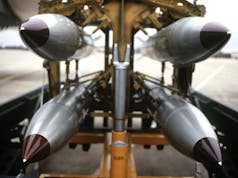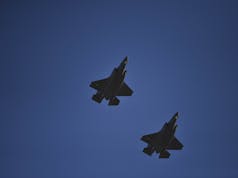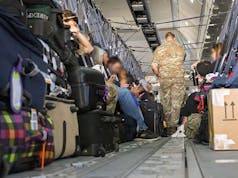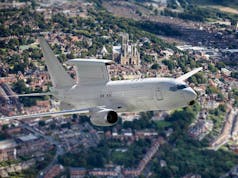BAE Systems has announced a critical milestone with the successful insertion of new technology into its EW systems for the global fleet of F-35 aircraft.
The company say that upgrades to the AN/ASQ-239 system position it ‘to meet future capability requirements’.
“The improved EW system delivers the world-class functionality of the previous system in a smaller footprint, reducing volume and power requirements – creating space for Block IV modernization upgrades.
The system update also resolves issues with manufacturing obsolescence that would have otherwise required costly redesign work. The company’s capacity expansion strategy – including a $100 million investment in 80,000 square feet of state-of-the-art manufacturing space, process automation, and the growth of its highly skilled electronic warfare workforce by more than 23 percent – enabled BAE Systems to become the first F-35 supplier to insert updated technology into its systems at full production speeds – delivering 11 systems monthly and ramping production to match aircraft production.”
The Digital Channelized Receiver/Techniques Generator and Tuner Insertion Program (DTIP) technology was introduced into BAE Systems’ manufacturing process in 2018 according to the firm, with the first deliveries starting in July.
“We’ve delivered almost 400 EW systems to date, and now we’ve updated the architecture and are manufacturing it at a high rate of production. This technology insertion gives the EW system room to grow, and will help the F-35 maintain its dominance of the electromagnetic spectrum,” said Deborah Norton, VP of F-35 Solutions at BAE Systems.
“The successful insertion of DTIP was the result of the outstanding focus, dedication, and teamwork of our engineering and production teams working in close coordination with our customer.”














Well, If I understood even a fraction of that, I’d consider myself to be Half Intelligent.
Well I think I get it. EW is firing lighting at each other right? Hence the name… ?
Oh, If you say so !!!!!
I’m not to Sharp when It comes to all that Clever Talk.
They have basically made the aircrafts electronic warfare system into a more compact design, so there is more internal room for growth. ?
In all seriousness is offensive EW just (just! As if it is easy) about blasting out signals to blind enemy radar and jam communications. The hard part being countering frequency hopping, various forms of wave modulation etc. whilst not blinding your own kit? This is my current understanding. Incomplete I am sure but if anyone can fill in the gaps in layman’s terms would much appreciate.
Without giving too much away. The EW system on the F35 is a step change over previous systems. It can do similar levels of sophisticated jamming as the F18 Growlers, but in a much smaller package. It uses a concept called digital radio frequency memory (DRFM) jamming. This is a technique that copies the signal transmitted from an enemy radar/radio and then rebroadcasts it. However, the copied signal is manipulated to either change the phase, amplitude or doppler frequencies (simplified). This can paint false targets on the enemy’s screen, give false distances to targets etc.
This is only one string to the bow of the F35’s EW suite, as its AN/APG-81 AESA radar should also be considered part of the EW suite. It has the ability to pinpoint an enemy radar and would use DRFM techniques to disable it.
Morning DaveyB
Fascinating post.
EW is not an area I am familiar with. I think you are saying with F35 around a dedicated SEAD aircraft is no longer necessary. There was talk once of F3’s being used in the role.
Yeah! What Robert said.
In addition to what’s already been said, I believe they’ve altered the software (and maybe the hardware) to make the EW suite easier to update going forward. This is something that’s being done to all of the F-35’s systems now they’re in production; the vast majority of improvements should now be more of a software update than a depot refit job.
Forgive me if this is something you already know, my understanding is that, in most modern military aircraft new capabilities have to be built into the software almost from the ground up. This takes a long time to implement and check that it doesn’t cause conflicts with other systems, which is partly why it is so expensive and time consuming to get new weapons systems signed off for Typhoon (for example). The F-35 is supposed to have a lot of this base-level work baked in already, so it is a lot simpler to add new capability. To take the example used earlier, the newer block F-35 weapons system has a universal interface to make adding additional weapons much easier. From what they’ve said above, BAE seem to have done the same with the EW suite.
It’s kind of the difference between having to write software from the most basic level up to interface each new mouse to your PC and make sure it doesn’t conflict with programming for the monitor or keyboard (old way), compared to plugging your mouse in and it just automatically interfacing its top-level driver with Windows (new way).
Its also that during the very long development of complex hardware such as fighters many components (particularly chips) become obsolete as technology moves on and there are fewer and fewer customers, production becomes either much more expensive due to becoming a low volume product or ceases entirely and they rely on stockpiles of spares built up knowing production was ceasing.
Im not claiming to understand all of it either, but I can seee the significance of being able to upgrade (and presumably retrofit) electronics packages very quickly. It must be a modular design. That’s very impressive.
Hi Dan, That is exactly what I’m saying. The F35 brings a lot to the table as a specialist strike aircraft, but also SEAD, ECM and ESM. The Aussies are going one step further in pairing their F35s with soon to be purchased F18 Growlers. This will allow the F35s to concentrate on the strike rather than worrying about ECM. In the UK I think it would be done slightly differently in that the F35s would be clearing the way for Typhoon by doing the jamming as well as SEAD.
The RAF did not have a dedicated SEAD aircraft like the German ECR Tornado. However, as part of a strike package each GR1 (back in the day) would have carried a pair of HARM or Alarm anti-radiation missiles. The Alarm was used extensively during the Gulf Wars and Libya very successfully, it was retired in 2013. We do not currently field a dedicated anti-radiation missile, however both AMRAAM and Meteor have a secondary anti-radiation capability. The other weapons we could use are Brimestone, LGB and SPEAR 3, with Storm Shadow for overkill.
Thank you Davey.
I believe ALARM, if I remember correctly, could deploy a parachute and “loiter” if radars turned off to wait for them to become active again.
That and Sea Eagle a needless loss I feel.
Was not aware AMRAAM or Meteor could be used as such.
They both have a passive RF seeker mode. However, the radar needs to stay on for them to track.
In short people BAR has decided that “we will not get away with it for much longer do we’ve finally done what you paid us to do four and a half years ago” “ oh and thanks for all the interest we’ve earnt out of you tax payers – ta ra” ps “we will come back for some extras to actually make it work shortly byeeee”